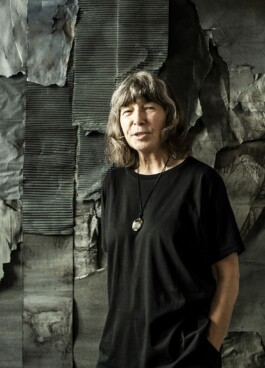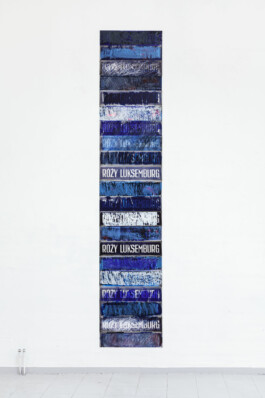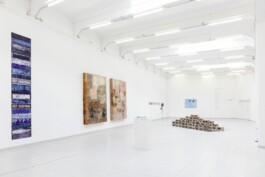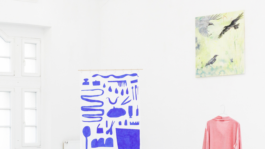(1)
In Conversation with
Anna Goebel
Anna Goebel, Artist Talk
Tanja Heuchele: Can you describe yourself in 5 sentences?
Anna Goebel: I feel a close symbiosis with the world of nature, with the multitude of its phenomena and structures. I am interested in its changeability and cyclicality. My projects are also variable systems, often only taking permanent forms for the duration of their exhibition. They are usually fragile and unstable. They become a metaphor for human existence.
TH: Your life without art would be…
AG: Would be incomplete, emptier. Art is an absolute necessity for me; it is the air and the breath that we cannot live without.
TH: What material inspires you the most? And which materials are you working with the most at the moment?
AG: The most inspiring for me are found materials, unnoticed by others, often part of nature, and sometimes things that have their own history. For the Kunsthalle project, I employed a “Roża Luksemburg” street nameplate removed from the building. To develop new ideas, I search for relevant solutions. Unknown techniques attract me. Discovering them is fascinating. This time I used PVC sheets, acrylic paints, mixed techniques, and screen-printing.
The Artist, Anna Goebel

Anna Goebel, Artist Talk
TH: Are there also materials that you would never use again?
AG: I don’t know. I don’t really exclude any materials.
TH: What literature did you study in preparing your art piece(s)?
AG: It was a tough task finding the literature in my mother tongue for the last project. On the Net, I most often encountered texts that falsified history and showed her (Rosa) in a bad light. Finally, I was able to dig down and make use of reliable sources. I used an independent history portal, academic writings, and independent historians’ research from many universities.
TH: What is your work about? What is your intention with it? What should it evoke in the viewer’s emotion?
AG: The work entitled “Obliterating from memory” concerns the erasure of the traces of Rosa Luxemburg in Poland. Nowadays her presence in my country is marginal, negligible. I was intrigued by the differences in the perception of this outstanding personality in my own country and outside. The work is basically a reflection, posing questions; a dialogue between different cultures.
Anna Goebel, Exhibition View, 2021

Anna Goebel, Artist Talk
TH: When did the journey with Who’s afraid of_Rosa begin for you, and what keeps you involved?
AG: I began my journey with “Who’s afraid of_Rosa” in 2018 when I decided to take part in this project. My interest was whetted by the fact that Rosa Luxemburg has been denied a presence in the life of our society and the distortion to which her story has been subjected. That was the moment when I started my research into her life and activities.
TH: How is the collective Who’s afraid of_Rosa organized? So far, I’ve only met female Rosa’s… can men also be part of it?
AG: The collective “Who’s afraid of Rosa” was highly professional. It was an open structure where everybody was able to find space. In my opinion, there’s no reasonable explanation why men should be excluded from participating in the project. Provided they have something valuable to add, of course.
TH: What does Rosa Luxemburg mean to you?
AG: She is a highly unusual personality, seen by many as ambiguous. She needs to be examined in the wider socio-political perspective. A thorough analysis of her life and activities is essential in order to form a judgment. Nevertheless, she was a real icon in her time.
TH: The subline of the exhibition is public space – private space – political space. What space do you (not) feel comfortable in? Where would you like to make a difference? What is your perception of space? Is it even the case that the above-mentioned spaces do not exist without each other?
AG: I feel more at ease in private space; in art I rarely touch on the political domain. But in this particular case, the reason I took up this issue was because of how the presence of Rosa Luxemburg has been underrated, or even actually eradicated from our common memory, and the historical facts have been distorted. I wanted my work to stimulate reflection, to provide impetus for gathering accurate knowledge about this outstanding individual, to be a dialogue between cultural differences.
TH: How do you react to people who are not familiar with art, and how do you think they can be made to understand better?
AG: You need to converse with the recipients. Sometimes provoke discussion. Invite them to meetings, lectures…
TH: What do you enjoy about your life as an artist?
AG: Freedom!!! Which certainly has its price. The life of an artist is difficult but rewarding. I am still curious about the world and about people. Discovering the unknown has accompanied me constantly. It continuously opens new doors for me.
TH: What is great art for you?
AG: The kind of art that banishes indifference, that dwells in my memory, inspires thoughts, delivers a message…
TH: What about your next projects, exhibitions? Where can you be seen next?
AG: I have been working on the cycle “From the Abundance”, which touches on the milieu that is closest to me. I found I was attracted to organic matter and its potential: orange and banana peel, red cabbage leaves… I transform them, changing their meaning and value.
Siehe auch
More Interviews




